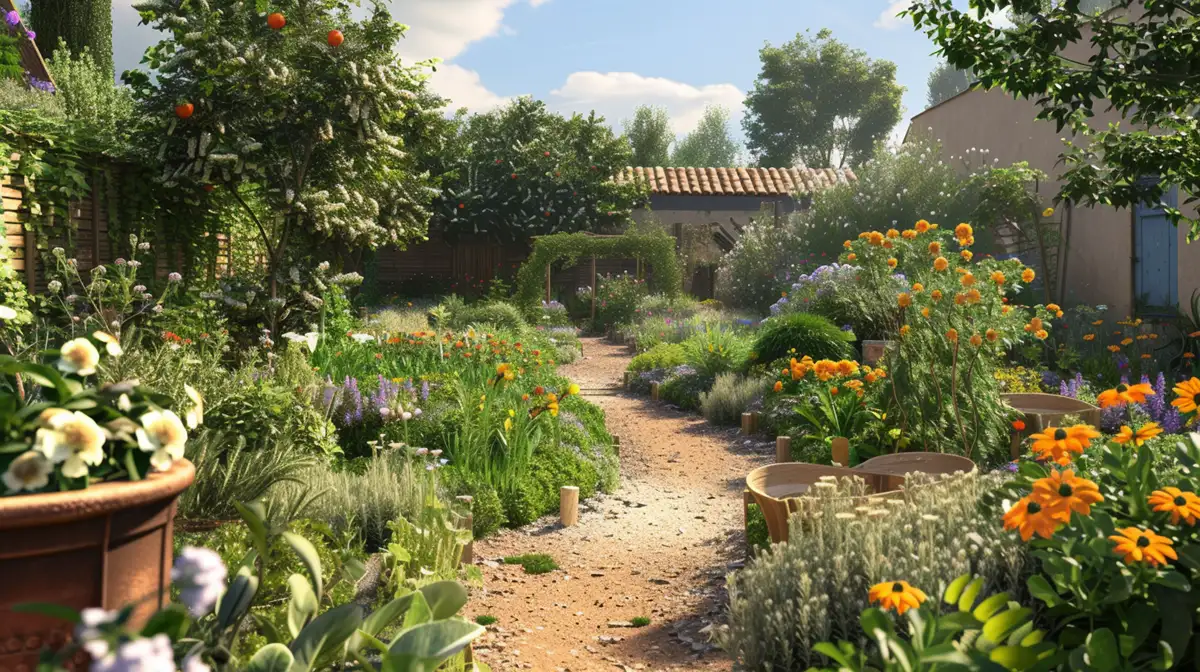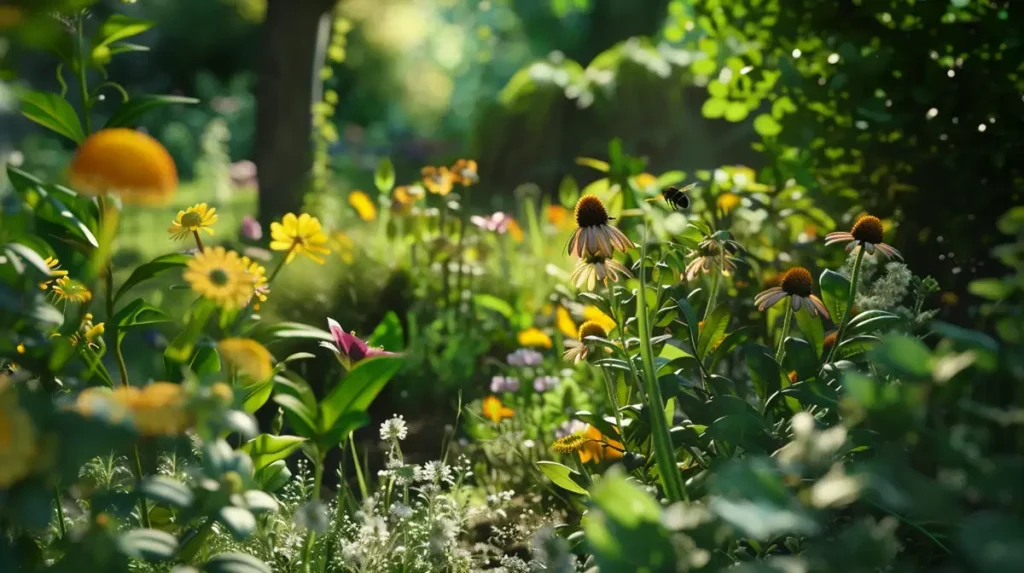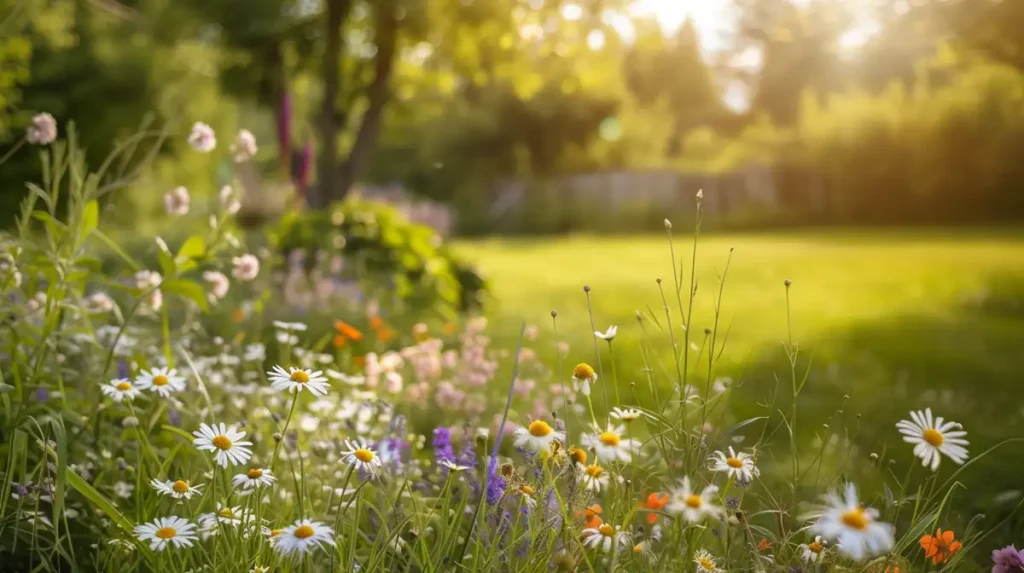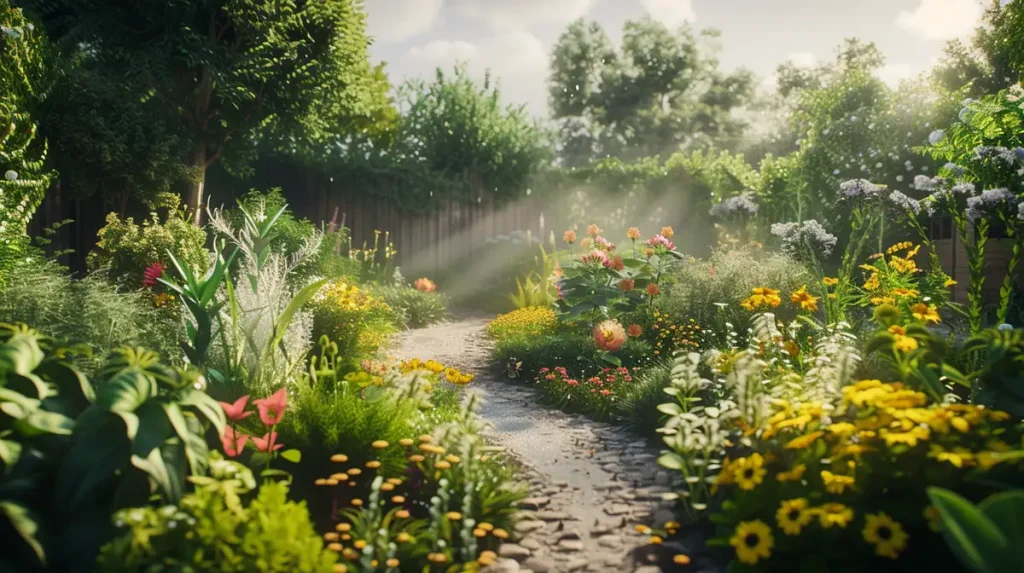Table of Contents
A bee-friendly garden features a variety of nectar and pollen-rich plants flowering at different times throughout the year, such as lavender, borage, and clover, to provide continuous food sources. Incorporating native plants, minimizing pesticide use, and providing water sources and undisturbed areas for nesting enhance habitat support for both honeybees and native bees.
In the below paragraphs, we will take a more detailed look at this topic.
Wondering how to create a bee friendly garden? Well, you’ve buzzed into the right place! Picture this: a warm summer afternoon, the sun shining brightly, and the gentle hum of bees as they go about their business in your very own backyard. You’re sitting back, sipping on some lemonade, and watching these buzzing beauties work their magic. Sounds pretty sweet, right? In this article, I’ll share with you the secrets to transforming your garden into a veritable bee utopia, filled with vibrant flowers and an abundance of pollinators.
Now, you might be wondering, “Why should I care about attracting bees to my garden?” Well, these tiny flying heroes play a crucial role in pollinating our plants, ensuring the continuation of our beloved fruits, vegetables, and flowers. Plus, who doesn’t love the idea of an all-natural, sustainable, and eco-friendly garden filled with life?
Let us explore the top tips, tricks, and plant selections for creating your very own bee haven. By the end of this article, you’ll be a bona fide bee-whisperer, ready to start your journey as a champion of these tiny, yet mighty, creatures! So, let’s get our hands dirty and do our part to save the bees – one garden at a time.

Why Bees Need Our Help
Bees are essential pollinators that are responsible for the growth and reproduction of many of our favorite fruits and vegetables. Without bees, our food supply would be severely threatened. In fact, it’s estimated that bees contribute to the production of one out of every three bites of food we eat.
Pesticides and Their Negative Impact on Bees
Unfortunately, bee populations are declining at an alarming rate due to a variety of threats. One of the biggest threats to bees is the widespread use of pesticides in agriculture and landscaping. Pesticides can be harmful to bees in a number of ways. For example, they can interfere with their ability to navigate and communicate with each other, making it harder for them to find food and return to their hives. Pesticides can also weaken bees’ immune systems, making them more susceptible to disease.
Habitat Loss and Its Impact on Bees
Another major threat to bees is habitat loss. As our cities and suburbs expand, natural habitats for bees are disappearing at an alarming rate. Bees rely on a variety of flowering plants for nectar and pollen; as these plants disappear, so do the bees.
The Impact of Climate Change on Bees
Climate change is also having an impact on bee populations. As temperatures rise, bees are being forced to travel farther and farther to find suitable habitats and food sources. This can be especially challenging for bees that are already struggling due to pesticides and habitat loss.
The Negative Impact of Non-Native Species on Bees
Finally, the introduction of non-native species of plants and animals can also have a negative impact on bee populations. Non-native plants may not provide the same quality or quantity of nectar and pollen that native plants do, while non-native animals like the Asian hornet can prey on bees and their nests.
Given the many threats facing bees, it’s more important than ever to create bee-friendly gardens and landscapes that support our buzzing friends. By choosing the right plants, avoiding pesticides, and providing nesting habitats, we can help ensure that bees have the food and shelter they need to thrive. In the next sections, we’ll explore some of the steps you can take to create a bee-friendly garden or landscape.

Choosing Plants for Your Bee-Friendly Garden
One of the most important things you can do to support bees is to choose the right plants for your garden. Bees are attracted to plants that are rich in nectar and pollen, so it’s important to select plants that provide these resources. In this section, we’ll take a closer look at the types of plants that are most attractive to bees and provide specific recommendations for bee-friendly flowers and plants.
- Carter, Anthony (Author)
- English (Publication Language)
- 194 Pages - 02/28/2024 (Publication Date) - Independently published (Publisher)
Characteristics of Plants That Attract Bees
When selecting plants for your bee-friendly garden, it’s important to look for plants that are rich in nectar and pollen. Bees are particularly attracted to flowers that are blue, purple, and yellow as these colors are more visible to them. They also prefer flowers with simple, open shapes that allow easy access to the nectar and pollen.
Recommended Plants for a Bee-Friendly Garden
Some of the best plants for attracting bees are lavender, sunflowers, daisies, zinnias, and herbs such as mint, thyme, and oregano. It’s important to plant these flowers in large clusters to create a “bee buffet” that will keep your buzzing friends coming back for more. Be sure to choose plants that bloom at different times throughout the year to provide a consistent source of food for bees.
Other Types of Plants That Attract Bees
In addition to planting flowers, it’s important to provide other types of plants that are attractive to bees. For example, trees such as apple, cherry, and plum are excellent sources of nectar and pollen and their blossoms provide an early-season food source for bees. Shrubs like blueberry and raspberry also provide nectar and pollen and they can be used to create hedges or windbreaks in your garden.
Flowering Vegetables for a Bee-Friendly Garden
Finally, don’t forget to include flowering vegetables in your bee-friendly garden. Vegetables like squash, pumpkin, and cucumbers produce large, showy flowers that are attractive to bees. These flowers provide an excellent source of nectar and pollen, and they can help to attract bees to your garden throughout the growing season.
Here is a table that provides a comprehensive guide, including plant names, bloom periods, plant types, sunlight needs, water requirements, and additional benefits to bees:
| Plant Name | Bloom Period | Plant Type | Sunlight Needs | Water Requirements | Additional Benefits to Bees |
|---|---|---|---|---|---|
| Lavender | June to August | Perennial | Full sun | Low | High nectar content, attracts a wide range of bees |
| Borage | June to September | Annual | Full sun | Medium | Excellent nectar producer, reseeds itself |
| Clover (White) | May to September | Perennial | Full sun to partial shade | Low to medium | Nitrogen-fixing, good for soil health, preferred by honeybees |
| Sunflower | July to September | Annual | Full sun | Medium to high | Provides pollen and nectar, supports a variety of bee species |
| Bee Balm | July to August | Perennial | Full sun to partial shade | Medium | High nectar, attracts both honeybees and native bees, medicinal uses |
| Echinacea (Coneflower) | June to August | Perennial | Full sun | Low to medium | Supports immune health of bees, attracts a wide range of pollinators |
| Foxglove | June to September | Biennial | Partial shade | Medium | Tubular flowers are attractive to long-tongued bees |
| Goldenrod | August to October | Perennial | Full sun | Low to medium | Late bloom period, critical for bees preparing for winter |
| Aster | August to October | Perennial | Full sun to partial shade | Medium | Late food source, supports a variety of pollinators |
| Salvia | May to September | Annual/Perennial depending on variety | Full sun | Low to medium | Rich in nectar, supports honeybees and native bees |
| Mint | June to September | Perennial | Full sun to partial shade | Medium | High nectar, invasive – best planted in containers |
| Hyssop | June to August | Perennial | Full sun | Low to medium | Attracts bees and butterflies, aromatic leaves, medicinal properties |
This table is a starting point for choosing plants for a bee-friendly garden. It’s important to select a mix of plants that bloom at different times to provide continuous support for bees. Additionally, choosing native plants can further enhance the garden’s attractiveness to local bee populations. Always consider the specific climate and soil conditions of your garden when selecting plants.
The Power of Native Plants in Your Garden
Incorporating native plants into the garden is a smart move when it comes to supporting local bee populations. These plants have co-evolved with the bees in your area and are more likely to offer the resources they need to thrive, such as nectar and pollen. In addition, native plants are generally better adapted to local soil and climate conditions, making them easier to grow and maintain.
To maximize the benefits for bees, do some research to identify the best native plants for your region. Consult local gardening experts, horticultural societies, or native plant nurseries for guidance. You’ll soon discover that there’s a wide range of beautiful native plants to choose from, many of which may be new to you.
Making a Splash: Providing Water for Bees
Just like us, bees need water to survive. Providing a water source in your garden can make a big difference to their wellbeing and encourage them to visit more frequently. You don’t need a large pond or fancy water feature; a simple, shallow birdbath or a small container filled with water will do the trick.
To make it bee-friendly, add some rocks, twigs, or floating plants to the water source, giving bees a safe place to land and drink. Make sure to keep the water clean and fresh, topping it up as needed, especially during hot and dry periods.
Plant Diversity: The Key to Supporting Bee Species
Creating a diverse garden is crucial to supporting a wide range of bee species. Planting a variety of flowers with different shapes, sizes, and blooming times means you’ll help create a more resilient and healthy ecosystem. This also ensures that there’s always something in bloom, providing a constant source of food for your buzzing visitors.
Consider incorporating plants with different bloom times, from early spring through late fall, to ensure a continuous supply of nectar and pollen. You can also mix up flower shapes and sizes to accommodate the varied preferences of different bee species.
Grass Be Gone: Reducing Lawn Space for a Bee-Friendly Habitat
While a well-manicured lawn may be visually appealing, it provides little to no benefit for bees. Reducing the size of the lawn and replacing it with flowering plants or native groundcovers can create a more bee-friendly habitat, as well as reducing the time and effort spent on lawn maintenance.
Consider transforming part or all of your lawn into a flowering meadow or wildflower garden, incorporating a mix of native plants that will not only support bees but also add color and interest to your landscape. Alternatively, try planting native groundcovers that require less maintenance than grass and provide essential nectar and pollen resources for bees.

Choosing Wisely: Avoiding Hybrid and Double-Flowered Plants
When selecting plants for your garden, it’s important to consider their appeal to bees. Hybrid and double-flowered plants often produce less nectar and pollen than their wild counterparts, making them less attractive to our buzzing friends. To create a bee-friendly environment, opt for single-flowered varieties and heirloom plants when possible.
Single-flowered plants typically have an open, accessible structure that makes it easy for bees to access the nectar and pollen. In contrast, double-flowered plants may have additional layers of petals that can make it difficult for bees to reach these resources. Heirloom plants are often rich in nectar and pollen, making them a great choice for a bee-friendly garden.
Going Green: Embracing Organic Gardening Practices
In addition to avoiding chemical pesticides, embracing organic gardening practices can help create a healthy and thriving garden ecosystem that supports bees. Consider implementing the following techniques:
- Composting: Create your own nutrient-rich compost from kitchen scraps, yard waste, and other organic materials. Compost not only provides essential nutrients to your plants but also improves soil structure and helps retain moisture.
- Mulching: Mulch your garden beds with organic materials like shredded leaves, straw, or wood chips. Mulching helps retain moisture, suppress weeds, and regulate soil temperature, all of which contribute to a healthier garden ecosystem.
- Natural Fertilizers: Instead of relying on synthetic fertilizers, use natural alternatives like compost, worm castings, or fish emulsion. These fertilizers provide essential nutrients without harming bees or other beneficial insects.
Spreading the Word: Educating Others About Bee-Friendly Gardens
Creating a bee-friendly garden is a fantastic start, but there’s more you can do. Sharing the importance of bee-friendly landscapes with friends, neighbors, and community members can promote awareness and encourage collective action in support of bees and other pollinators. Here are some ideas for spreading the word:
- Social Media: Share photos and stories of your bee-friendly garden on social media platforms along with tips and resources for others interested in creating their own pollinator havens.
- Community Events: Participate in local gardening clubs, workshops, or community garden projects, and use these opportunities to discuss the importance of bee-friendly gardens.
- Educational Programs: Collaborate with schools, libraries, or community centers to develop educational programs about bees and the benefits of bee-friendly gardening practices. You can even consider hosting a workshop or demonstration in your own garden.
Avoiding Pesticides in Your Bee-Friendly Garden
Pesticides are one of the biggest threats to bees and other beneficial insects, and it’s important to avoid using chemical pesticides in your garden. In this section, I’ll discuss the dangers of pesticides to bees and explore alternatives to chemical pesticides for pest control.
The Dangers of Pesticides to Bees
Chemical pesticides can be harmful to bees in a number of ways. For example, they can interfere with bees’ ability to navigate and communicate with each other, making it harder for them to find food and return to their hives. Pesticides can also weaken bees’ immune systems, making them more susceptible to disease. In addition, pesticides can be harmful to other beneficial insects like ladybugs and lacewings, which help to control garden pests naturally.
Natural Alternatives for Pest Control
To avoid using chemical pesticides in your garden, consider using natural alternatives for pest control. One of the simplest and most effective ways to control pests in your garden is to use companion planting. Companion planting involves planting two or more different types of plants together in order to deter pests or attract natural predators.
For example, planting marigolds near your vegetables can help to deter pests like nematodes and aphids while attracting beneficial insects like ladybugs and lacewings. Planting mint and basil near your tomatoes can help to repel pests like whiteflies and spider mites while also providing a source of nectar for bees and other beneficial insects.
In addition to companion planting, there are several other natural pest control strategies you can use in your garden. These include handpicking pests, using row covers, and introducing natural predators like ladybugs and praying mantises.
Protecting Bees and Beneficial Insects
By avoiding chemical pesticides in your bee-friendly garden and using natural alternatives instead, you can help to protect bees and other beneficial insects while still keeping your garden pest-free. So get creative with your pest control strategies and watch your garden thrive with buzzing activity!
Providing Nesting Habitats for Wild Bees
Many bee species are solitary bees that do not live in hives like honeybees. Instead, they nest in the ground, in hollow stems, or in other small spaces. Providing nesting habitats for these wild bees is an important way to support their populations and ensure that they can continue to pollinate plants in your garden and beyond. Let’s take a closer look at the different types of wild bees and their nesting habits and some tips for providing nesting habitats in your garden or landscape.
Types of Wild Bees and their Nesting Habits
There are over 4,000 species of native bees in North America alone, and each has its own unique nesting habits. Some bees, like the mason bee, nest in hollow stems like those of bamboo, while others, like the mining bee, nest in the ground. In general, most native bees are solitary and do not form large colonies like honeybees. Instead, they live alone or in small groups, and each female bee builds her own nest.
Creating Nesting Habitats for Wild Bees
To provide nesting habitats for wild bees in your garden or landscape, you can create a “bee hotel” using hollow bamboo or reed stems. Simply bundle several stems together and hang them in a sheltered area of your garden. You can also create nesting habitats for ground-nesting bees by leaving areas of bare ground in your garden or landscape. These areas should be in a sunny location and free of vegetation, as ground-nesting bees need access to the soil.
Incorporating Nesting Habitats into Garden Design
Another way to provide nesting habitats for wild bees is to use a “bee block”. A bee block is a wooden block with drilled holes of different sizes that can provide nesting cavities for bees. You can make your own bee block by drilling holes of different sizes into a wooden block, or you can purchase pre-made bee blocks online or at your local garden center.
Importance of Providing Nesting Habitats for Wild Bees
It’s important to note that providing nesting habitats for wild bees does not mean that you need to leave your garden or landscape messy or unkempt. Instead, you can incorporate nesting habitats into your garden design in a way that looks natural and attractive. For example, you can create a bee hotel and hang it on a trellis or decorative fence, or you can incorporate a bee block into a raised garden bed.
How to Create a Bee Friendly Garden – Conclusion
Creating a bee-friendly garden or landscape is a simple but important way to support our buzzing friends. By choosing the right plants, avoiding pesticides, and providing nesting habitats, you can help ensure that bees have the food and shelter they need to thrive. So if you’re a beekeeper or just a lover of nature, take action and create your own bee-friendly garden today. Your buzzing friends will thank you!
Last update on 2024-04-25 / Affiliate links / Images from Amazon Product Advertising API


